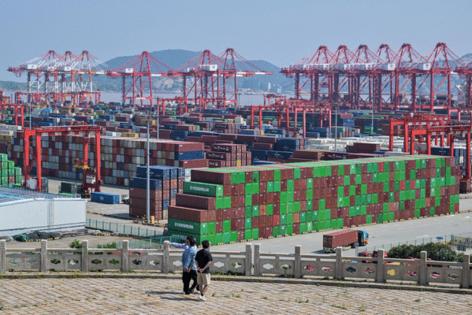Trump announces additional 100% China tariff, tech controls
Published in News & Features
WASHINGTON — U.S. President Donald Trump said he would impose an additional 100% tariff on China and export controls on “any and all critical software” beginning Nov. 1, hours after threatening to cancel an upcoming meeting with the country’s leader, Xi Jinping.
“It has just been learned that China has taken an extraordinarily aggressive position on Trade in sending an extremely hostile letter to the World, stating that they were going to, effective November 1st, 2025, impose large scale Export Controls on virtually every product they make, and some not even made by them,” Trump said in a social media post.
The declaration came after Trump earlier Friday threatened trade actions against China, citing “hostile” export controls Beijing placed on rare-earth minerals. Trump also said there seemed to be “no reason” to follow through with a planned meeting with Xi on the sidelines of the Asia-Pacific Economic Cooperation summit in South Korea later this month, though the timing of the newly announced tariffs still leaves room for that meeting to occur before they go into effect.
The threat of a massive tariff escalation will revive fears of a global disruption in trade that could see the world’s two largest economies effectively cut off ties, and dramatically raises the stakes for Trump and Xi as they navigate high-stake trade negotiations.
Trump’s announced tariffs would raise import taxes on many Chinese goods to 130% starting next month. That would be just below the 145% level imposed earlier this year, before both countries ratcheted down the levies in a truce to advance trade talks.
Markets recoiled at the president’s comments earlier Friday, with U.S. stocks suffering their worst selloff in six months. The S&P 500 Index wiped out its weekly advance after tumbling 2.7%, its worst day since April 10. The Nasdaq 100 Index sank 3.5%. Chicago soybean futures fell as much as 1.9%.
Ahead of the planned meeting, both the U.S. and China moved to potentially curb flows of technology and materials between the countries — which had been seen as ways to gain an edge in the talks. Some of the latest measures announced by Beijing were set to be enforced by Nov. 8, so would not be in effect before the leaders met.
In the most recent action, China slapped new port fees on U.S. ships and started an antitrust investigation into Qualcomm Inc. — following fresh efforts to restrict the flow of rare-earth minerals needed to make numerous consumer products, including motors, semiconductors and fighter jets.
The announcement puts in doubt not only the agenda for Trump’s planned trip to Asia, which included a meeting with Xi this month at the APEC summit, but also the future of negotiations over China’s refusal to purchase U.S. soybeans, which has hammered American farmers.
“This back and forth indicates the fragility of the bilateral relationship,” said Wendy Cutler, a former U.S. trade negotiator. “It is by no means certain that cooler heads will prevail leading to a de-escalation in time” for the leaders’ planned meeting.
Rare earth materials have been at the center of trade brinkmanship between Washington and Beijing. After Trump hiked tariffs on Chinese imports earlier this year, China’s government responded by cutting off mineral exports to U.S. companies. Officials from both sides agreed to a truce in the spring, under which Trump lowered duties and Xi’s officials agreed to resume the flow of the minerals.
But on Thursday, China required that overseas exporters of items that use even traces of certain rare earths to obtain an export license, according to the Ministry of Commerce, citing national-security concerns. Some equipment and technology for processing rare earths and making magnets will also be subject to controls, the ministry said in a separate release.
It’s not clear what software products from the U.S. might be hit by Trump’s proposed export ban.
Trump’s moves mark an abrupt change in tone even from Thursday, when he expressed optimism that he could convince Xi to end China’s moratorium on U.S. soybean buys and said of the Chinese leader, “he’s got things that he wants to discuss with me, and I have things that I want to discuss with him.”
Tensions have fluctuated for months between the U.S. and China as the two sides have jockeyed for leverage across a range of issues up for negotiation, including tariffs, countering fentanyl flows, soybeans, export controls, and the fate of Chinese-owned social media giant TikTok’s U.S. operations. The latest trade truce between the economies suspended elevated U.S. duties on China until November.
“Our relationship with China over the past six months has been a very good one, thereby making this move on Trade an even more surprising one,” Trump said in his initial Truth Social post. “I have always felt that they’ve been lying in wait, and now, as usual, I have been proven right!”
Trump claimed that he’d heard from other global trading partners who he said had received similar letters and were “extremely angry at this great Trade hostility” from China.
The president also expressed annoyance at the timing of the Chinese letters, coming as he’s planning to visit the Middle East to herald a peace deal he helped broker between Israel and Hamas.
“The Chinese letters were especially inappropriate in that this was the Day that, after three thousand years of bedlam and fighting, there is PEACE IN THE MIDDLE EAST,” Trump wrote.
_____
With assistance from Michelle Jamrisko.
_____
©2025 Bloomberg L.P. Visit bloomberg.com. Distributed by Tribune Content Agency, LLC.







Comments